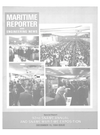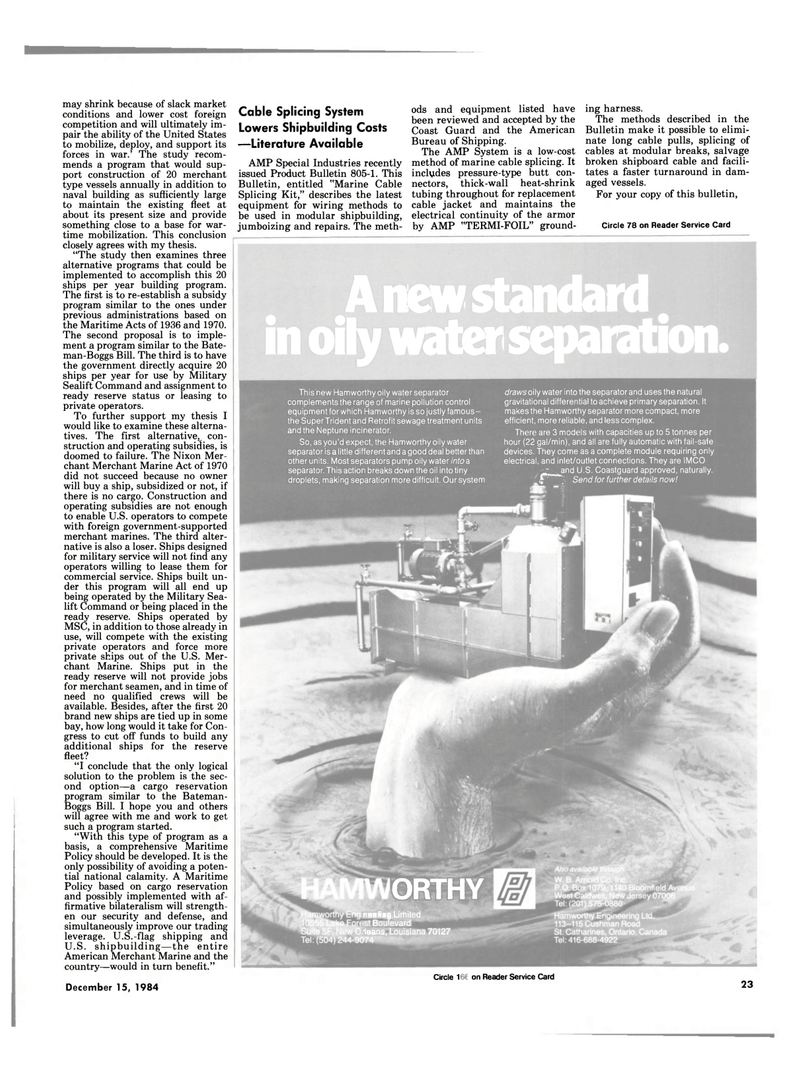
Page 21: of Maritime Reporter Magazine (December 15, 1984)
Read this page in Pdf, Flash or Html5 edition of December 15, 1984 Maritime Reporter Magazine
may shrink because of slack market conditions and lower cost foreign competition and will ultimately im- pair the ability of the United States to mobilize, deploy, and support its forces in war.' The study recom- mends a program that would sup- port construction of 20 merchant type vessels annually in addition to naval building as sufficiently large to maintain the existing fleet at about its present size and provide something close to a base for war- time mobilization. This conclusion closely agrees with my thesis. "The study then examines three alternative programs that could be implemented to accomplish this 20 ships per year building program.
The first is to re-establish a subsidy program similar to the ones under previous administrations based on the Maritime Acts of 1936 and 1970.
The second proposal is to imple- ment a program similar to the Bate- man-Boggs Bill. The third is to have the government directly acquire 20 ships per year for use by Military
Sealift Command and assignment to ready reserve status or leasing to private operators.
To further support my thesis I would like to examine these alterna- tives. The first alternative, con- struction and operating subsidies, is doomed to failure. The Nixon Mer- chant Merchant Marine Act of 1970 did not succeed because no owner will buy a ship, subsidized or not, if there is no cargo. Construction and operating subsidies are not enough to enable U.S. operators to compete with foreign government-supported merchant marines. The third alter- native is also a loser. Ships designed for military service will not find any operators willing to lease them for commercial service. Ships built un- der this program will all end up being operated by the Military Sea- lift Command or being placed in the ready reserve. Ships operated by
MSC, in addition to those already in use, will compete with the existing private operators and force more private ships out of the U.S. Mer- chant Marine. Ships put in the ready reserve will not provide jobs for merchant seamen, and in time of need no qualified crews will be available. Besides, after the first 20 brand new ships are tied up in some bay, how long would it take for Con- gress to cut off funds to build any additional ships for the reserve fleet? "I conclude that the only logical solution to the problem is the sec- ond option—a cargo reservation program similar to the Bateman-
Boggs Bill. I hope you and others will agree with me and work to get such a program started. "With this type of program as a basis, a comprehensive Maritime
Policy should be developed. It is the only possibility of avoiding a poten- tial national calamity. A Maritime
Policy based on cargo reservation and possibly implemented with af- firmative bilateralism will strength- en our security and defense, and simultaneously improve our trading leverage. U.S.-flag shipping and
U.S. shipbuilding—the entire
American Merchant Marine and the country—would in turn benefit."
December 15, 1984
Cable Splicing System
Lowers Shipbuilding Costs —Literature Available
AMP Special Industries recently issued Product Bulletin 805-1. This
Bulletin, entitled "Marine Cable
Splicing Kit," describes the latest equipment for wiring methods to be used in modular shipbuilding, jumboizing and repairs. The meth- ods and equipment listed have been reviewed and accepted by the
Coast Guard and the American
Bureau of Shipping.
The AMP System is a low-cost method of marine cable splicing. It includes pressure-type butt con- nectors, thick-wall heat-shrink tubing throughout for replacement cable jacket and maintains the electrical continuity of the armor by AMP "TERMI-FOIL" ground- ing harness.
The methods described in the
Bulletin make it possible to elimi- nate long cable pulls, splicing of cables at modular breaks, salvage broken shipboard cable and facili- tates a faster turnaround in dam- aged vessels.
For your copy of this bulletin,
Circle 78 on Reader Service Card
Circle 128 on Reader Service Card 23 1
A new standard in oily water separation drawsoily water into the separator and uses the natural gravitational differential to achieve primary separation. It makes the Hamworthy separator more compact, more efficient, more reliable, and less complex.
There are 3 models with capacities up to 5 tonnes per hour (22 gal/min), and all are fully automatic with fail-safe devices. They come as a complete module requiring only electrical, and inlet/outlet connections. They are IMCO ~ and U.S. Coastguard approved, naturally. ,f Send for further details now!
This new Hamworthy oily water separator complements the range of marine pollution control equipment for which Hamworthy is so justly famous- the Super Trident and Retrofit sewage treatment units and the Neptune incinerator.
So, as you'd expect, the Hamworthy oily water separator is a little different and a good deal better than other units. Most separators pump oily water into a separator. This action breaks down the oil into tiny droplets, making separation more difficult. Oursystem
ORTHY neering Limited ist Boulevard -leans, Louisiana 70127

 20
20

 22
22
